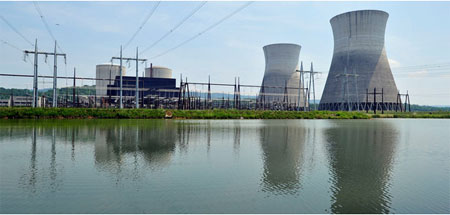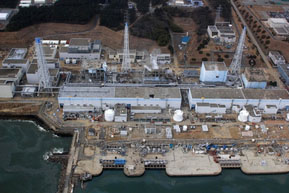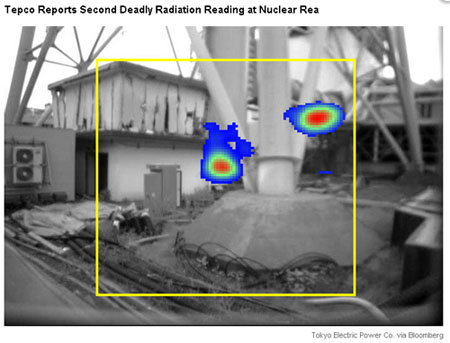Author Archive
Alabama Nuclear Reactor, Partly Built, to Be Finished

Photo: Eric Schultz/Associated Press
The Tennessee Valley Authority’s never-completed Bellefonte nuclear plant in Hollywood, Ala.
August 18, 2011
By MATTHEW L. WALD
New York Times
The directors of the Tennessee Valley Authority unanimously approved a plan on Thursday to finish the partly built Bellefonte 1 nuclear reactor, a project on which the authority spent billions of dollars in the 1970s and ’80s but dropped in 1988 because of cost overruns and declining estimates of power demand.
The revived reactor, in Hollywood, Ala., is not expected to be completed before 2018 to 2020 — or about a half-century after the project was first announced, and following nearly a quarter-century of limbo.
"The T.V.A, has wrestled with the fate of Bellefonte since 1988," said Marilyn A. Brown, a board member who is a professor of energy policy at the Georgia Institute of Technology’s School of Public Policy. The decision comes at a time when other countries, Germany and Switzerland, for example, are leaning away from nuclear power and closing older plants, after the meltdowns at the Fukushima Daiichi reactor complex in Japan in March.
The long-anticipated "nuclear renaissance" in the United States appears to have stalled as well, with only four reactors currently being built, two in Georgia and two in South Carolina.
Meet the Shady Dallas Mega-Billionaire Industrialist Pouring Money into Rick Perry’s Coffers
August 29, 2011
By Joe Conason
AlterNet

Most Americans have never heard of Harold Simmons, despite his fantastic wealth, because he wisely keeps his head low.
Like so many Republican officials of the tea party persuasion, Rick Perry despises the Environmental Protection Agency-a feeling he has expressed repeatedly in speeches, lawsuits, legislation and even a book titled "Fed Up!" Perhaps that is only natural for the governor of Texas, a "dirty energy" state where the protection of air, water and human health rank well below the defense of oil company profits for most politicians.
But Perry has at least one other reason for smacking down those bureaucrats so eagerly. When environmental regulators do their job properly, that can mean serious trouble for Perry’s largest political donors.
The outstanding example is Harold Simmons, a Dallas mega-billionaire industrialist who has donated well over a million dollars to Perry’s campaign committees recently. With Perry’s eager assistance-and despite warnings from Texas environmental officials-Simmons has gotten approval to build an enormous radioactive waste dump on top of a crucial underground water supply.
"We first had to change the law to where a private company can own a license, and we did that," Simmons boasted in 2006, after the Texas Legislature and the governor rubber-stamped initial legislation and approvals for the project. "Then we got another law passed that said (the state) can only issue one license. Of course, we were the only ones that applied."
Most Americans have never heard of Simmons, despite his fantastic wealth, because he wisely keeps his head low, generally refusing press interviews and avoiding media coverage. Last year, a local monthly in his hometown published the headline "Dallas’ Evil Genius" over a scathing and fascinating investigative profile that examined not only the peculiar history of litigation between Simmons and his children (who no longer speak to him), but his political machinations, corporate raiding and continuing corporate penchant for pollution.
In D magazine, reporter Laray Polk explained how Simmons and a company he owns-innocuously named Waste Control Systems-manipulated state and federal law to allow him to build a nuclear-waste disposal site in West Texas. But construction has been delayed for years in part because the site appears to overlay the Oglalla Aquifer, an underground water supply that serves 1.9 million people in nine states, raising obvious concerns over radioactive contamination. In the Simmons profile and subsequent posts on the Investigative Fund website last year, Polk explored the controversy over the proposed WCS facility, including strong objections by staff analysts at the Texas Commission on Environmental Quality who found evidence that atomic waste might indeed leach into a huge pool of drinking water.
Now reporters for The Los Angeles Times have revived, advanced and updated the WCS story with much additional detail, including interviews with the Texas environmental officials who oversaw the approval process for the facility. For a period last summer, that process appeared to have been slowed down to allow serious consideration of the scientific data collected by the commission’s staff.
In other words, the regulators were trying to do their job, which meant expensive delays and perhaps an eventual ruling against the nuclear waste site. That would have protected the Oglalla Aquifer and cost Simmons hundreds of millions in lost investment and profit. But then Perry’s appointees on the commission voted by two to one to issue licenses for the WCS site.
This year, officials on another Texas commission appointed by Perry-who oversee low-level radioactive waste in the state-voted to allow the WCS site to accept nuclear waste from 34 other states in a highly controversial decision later ratified by the state Legislature and signed by Perry himself. Not long after that, according to The Los Angeles Times’ report, Simmons gave $100,000 to Americans for Rick Perry, an "independent" committee supporting his presidential candidacy. (Back in 2004, Simmons was a major contributor to another "independent" political committee, the notorious Swift Boat Veterans group that distorted Democratic presidential nominee John Kerry’s war record in a series of TV ads.)
According to a spokesman for WCS, the Texas governor’s happy and lucrative relationship with Simmons did nothing to help the company except to turn the billionaire into "an easy target. … It made the state redouble its efforts to be thorough." But the Texas officials who opposed the approval on principle have since quit their jobs with the state. As one of them told the L.A. Times reporters, "This is a stunningly horrible public policy to grant a license to this company for that site … . Something had to happen to overcome the quite blatant shortcoming of that application. … The only thing I know in Texas that has the potential to do that is money in politics."
As for the Texas official (and Perry appointee) who overruled his own scientists and approved the deal, he left state government, too-to work as a lobbyist for Simmons. He says that no undue influence led to the favorable outcome for his new employer.
Texas must be the only place on earth where anyone would believe that.
Joe Conason is the editor in chief of NationalMemo.com.
© 2011 Creators.com
This document contains copyrighted material whose use has not been specifically authorized by the copyright owner. SEED Coalition is making this article available in our efforts to advance understanding of ecological sustainability, human rights, economic democracy and social justice issues. We believe that this constitutes a "fair use" of the copyrighted material as provided for in section 107 of the US Copyright Law. If you wish to use this copyrighted material for purposes of your own that go beyond "fair use", you must obtain permission from the copyright owner.
Milton Lee returns as Perry’s dump pick
September 21, 2011
San Antonio Current Blog – The Que Que
Remember when we suggested Rick Perry was looking for stooges to help turn one of his top funder’s nuclear dumps into a national enterprise? Well, he had to look no further than former CPS Energy CEO Milton Lee. Perry’s new appointments to the state commission governing the two-state Texas-Vermont Low-Level Radioactive Waste Disposal Compact Commission, announced last week, brought in a slate of new faces who will help determine the future of radioactive-waste dumping in Texas — and how much Dallas billionaire Perry donor Harold Simmons will make on the state’s favored Waste Control Specialists’ site in Andrews County.
Lee, who made his exit as CEO of San Antonio’s city-owned power utility last year, enjoyed a rocky tenure. One of the chief architects of the proposed expansion of the South Texas (nuclear) Project, now on hold as the Fukushima radioactive dust continues to settle, Lee helped implement years of aggravated attrition at CPS, forcing the exit of hundreds of employees and prompting a lawsuit from the International Brotherhood of Electrical Workers alleging dozens of cases of sex-, age-, and race-based discrimination.
Karen Hadden, director of the Austin-based SEED Coalition, said Lee’s appointment to the radwaste commission raises serious questions, given the gravity of decisions the commission will make in the coming years – namely, whether or not to make WCS the nation’s radwaste dumping grounds. Lee’s track record for environmental concern, she claims, is dubious, pointing to Lee’s role in helping form the Climate Policy Group, which consisted mostly of publicly-owned utilities heavily invested in coal power. Under Lee, the utility spent more than $120,000 lobbying against cap-and-trade policies through member dues to the CPG and trips to Washington D.C.
What’s notable, but unsurprising, is whom Perry failed to reappoint — Bobby Gregory, the commission’s persistent opposing voice, who had been a thorn in the side of radwaste expansionists. Perry had tried to coax Gregory off the radwaste commission by offering him a prestigious board-of-regents appointment, which would have conveniently required him to step down from the radwaste commission before it voted on whether to open up the West Texas dump to waste from an additional 34 states, something Gregory openly opposed (the commission ultimately passed the proposal).
This document contains copyrighted material whose use has not been specifically authorized by the copyright owner. SEED Coalition is making this article available in our efforts to advance understanding of ecological sustainability, human rights, economic democracy and social justice issues. We believe that this constitutes a "fair use" of the copyrighted material as provided for in section 107 of the US Copyright Law. If you wish to use this copyrighted material for purposes of your own that go beyond "fair use", you must obtain permission from the copyright owner.
Tepco Reports Second Deadly Radiation Reading at Fukushima Nuclear Plant
Fri Sep 16, 2011
By MARK DUNPHY
Irish Weather Online

Damaged Fukushima Nuclear Plant
Radioactive Substances May Return To Japanese Coast In 20-30 Years
A new study shows radioactive substances which leaked into the sea after March’s Fukushima crisis could return to Japanese coasts in 20 to 30 years, local media reported on Friday.
The research investigation was carried out by the Meteorological Research Institute and the Central Research Institute of Electric Power Industry, indicating that the leaked radioactive cesium is likely to circulate through the northern Pacific Ocean in a clockwise pattern before returning to Japan’s coast line in two or three decades, the Kyodo news agency reported.
The study also showed that the estimated amount of radioactive cesium-137 which was directly released into the sea from March until the end of May was about 3,500 terabecquerels. It also estimated that about 10,000 terabecquerels of additional cesium-137 dropped into the ocean after it was released into the air.
Ocean currents are expected to disperse the radioactive substance eastward and into the northern Pacific Ocean. According to the research, the current from around the Philippines would carry the cesium back to the country after previously shifting southwestward.
With an estimated half life of about 30 years, studies have shown that cesium-137 can cause cancer as it accumulates in the body’s muscle system once inside the human body.
High levels of radioactive cesium have also been found in Japanese beef. The latest case occurred last week in the country’s Iwate Prefecture, located in the Tohoku region of Honshu Island, as tests showed that two of eight beef cattle being shipped exceeded the government’s allowable limit of 500 becquerels of cesium per kilogram (2.25 pounds).
In July, radioactive cesium was found in straw fed to cattle at a farm in Minamisoma, Fukushima Prefecture with an average of 75,000 becquerels of the radioactive isotope per kilogram (2.25 pounds), which is about 56 times the allowable limit.
Japan has been facing an ongoing nuclear crisis since the Fukushima Daiichi nuclear power plant was severely damaged on March 11 when a 9.0-magnitude earthquake and a subsequent tsunami devastated the country. The disaster disabled the cooling systems of the plant, and radioactive elements leaked into the sea and were later found in water, air and food products in some parts of Japan.
At least 23,482 people were killed, while 8,069 people remain missing. There are still more than 88,000 people who are staying in shelters in 21 prefectures around Japan.
This document contains copyrighted material whose use has not been specifically authorized by the copyright owner. SEED Coalition is making this article available in our efforts to advance understanding of ecological sustainability, human rights, economic democracy and social justice issues. We believe that this constitutes a "fair use" of the copyrighted material as provided for in section 107 of the US Copyright Law. If you wish to use this copyrighted material for purposes of your own that go beyond "fair use", you must obtain permission from the copyright owner.
Tepco Reports Second Deadly Radiation Reading at Fukushima Nuclear Plant
Aug 3, 2011
By Tsuyoshi Inajima and Kari Lundgren
Bloomberg News

A handout photograph shows a gamma camera image of an area around the main
exhaust stuck of Unit 1 and 2 at Tokyo Electric Power Co.’s
(Tepco) Fukushima Dai-Ichi nuclear power station in Fukushima, Japan, on Monday, Aug. 1, 2011. On Aug. 1 in another area it recorded radiation of 10 sieverts per hour, enough to kill a person "within a few weeks" after a single exposure, according to the World Nuclear Association. Source: Tokyo Electric Power Co. via Bloomberg
Tokyo Electric Power Co. reported its second deadly radiation reading in as many days at its wrecked Fukushima nuclear plant north of Tokyo. The utility known as Tepco said yesterday it detected 5 sieverts of radiation per hour in the No. 1 reactor building. On Aug. 1 in another area it recorded radiation of 10 sieverts per hour, enough to kill a person "within a few weeks" after a single exposure, according to the World Nuclear Association.
Radiation has impeded attempts to replace cooling systems to bring three melted reactors and four damaged spent fuel ponds under control after a tsunami on March 11 crippled the plant. The latest reading was taken on the second floor of the No. 1 reactor building and will stop workers entering the area.
"It’s probably the first of many more to come," said Michael Friedlander, who spent 13 years operating nuclear power plants in the U.S., including the
Crystal River Station in Florida. "Although I am not surprised, it concerns me greatly; the issue is the worker safety." The 10 sieverts of radiation detected on Aug. 1 outside reactor buildings was the highest the Geiger counters used were capable of reading, indicating the level could have been higher, Junichi Matsumoto, a general manager at the utility, said at a press conference.
Upper Limit
"Ten sieverts is the upper limit for many dosimeters and almost equal to the amount that killed workers at the JCO nuclear accident in 1999," said Tomoko
Murakami, a nuclear researcher at the Institute of Energy Economics, Japan. In that accident, then the world’s worst since Chernobyl in 1986, more than 600 people were exposed to radiation after workers inadvertently started a nuclear chain reaction while processing nuclear fuel at a plant near Tokyo. Two employees of JCO Co., a wholly-owned subsidiary of Sumitomo Metal Mining Co., died from radiation exposure.
Tepco was forced to pump water into the three Fukushima reactors after the March 11 earthquake and tsunami disabled cooling systems. The company in May estimated there would be 200,000 tons of radiated water in basements and other areas of the Fukushima Dai-Ichi plant by December. "If nuclear fuels melted through containment chambers, Tepco will find even higher radiation readings after water in building basements is removed," said Tetsuo Ito, the head of the Atomic Energy Research Institute at Kinki University.
Radiation Leaks
Tepco has been criticized by the government for withholding radiation data and other missteps that have worsened the crisis. About 160,000 people have been evacuated from areas stretching 20 kilometers and more from the plant. On May 27, Chief Cabinet Secretary Yukio Edano said Tepco’s withholding radiation data was contributing to "public distrust." The utility responded by saying it will publish in August the combined figures of radiation released into the atmosphere and in contaminated water. It hasn’t given a date for release of that information.
Radiation leaks from the Fukushima reactors have spread over 600 square kilometers, Tomio Kawata, a fellow at the Nuclear Waste Management Organization of Japan, said in a research report published on May 24 and given to the government.
Radioactive soil in pockets of areas outside the exclusion zone around the plant have reached the same level as in Chernobyl following a reactor explosion in the former Soviet Union, the report said.
Hot Spots
The threats to Japan’s food chain are also multiplying as radioactive cesium emissions from the Fukushima plant spread. Contaminated beef has been found on supermarket shelves around the country, forcing the government to ban cattle shipments from areas in northern Japan. The latest high radiation readings are probably coming from materials released during early failed attempts to release pressure in containment vessels and vent hydrogen gas to prevent explosions that damaged reactor buildings, Matsumoto said. There were about 2,760 workers at the plant on Aug 1.
Tepco on April 17 set out a so-called road map to end the crisis by January, aiming to bring down radiation levels at the plant within three months and then achieve a so-called cold shutdown where reactor temperatures fall below 100 degrees Celsius (212 degrees Fahrenheit). The utility needs to investigate other areas that may hold high radiation levels in line with the cold-shutdown and clean up, said Murakami at Energy Economics.
"Tepco workers and its subcontractors who know the Fukushima plant well may be the only ones that can discover such hot spots," he said. "For people new to the plant it’s deadly."
To contact the reporters on this story: Tsuyoshi Inajima in Tokyo at tinajima(at)bloomberg.net; Kari Lundgren in London at klundgren2(at)bloomberg.net To contact the editor responsible for this story: Peter Langan at plangan(at)bloomberg.net
This document contains copyrighted material whose use has not been specifically authorized by the copyright owner. SEED Coalition is making this article available in our efforts to advance understanding of ecological sustainability, human rights, economic democracy and social justice issues. We believe that this constitutes a "fair use" of the copyrighted material as provided for in section 107 of the US Copyright Law. If you wish to use this copyrighted material for purposes of your own that go beyond "fair use", you must obtain permission from the copyright owner.


